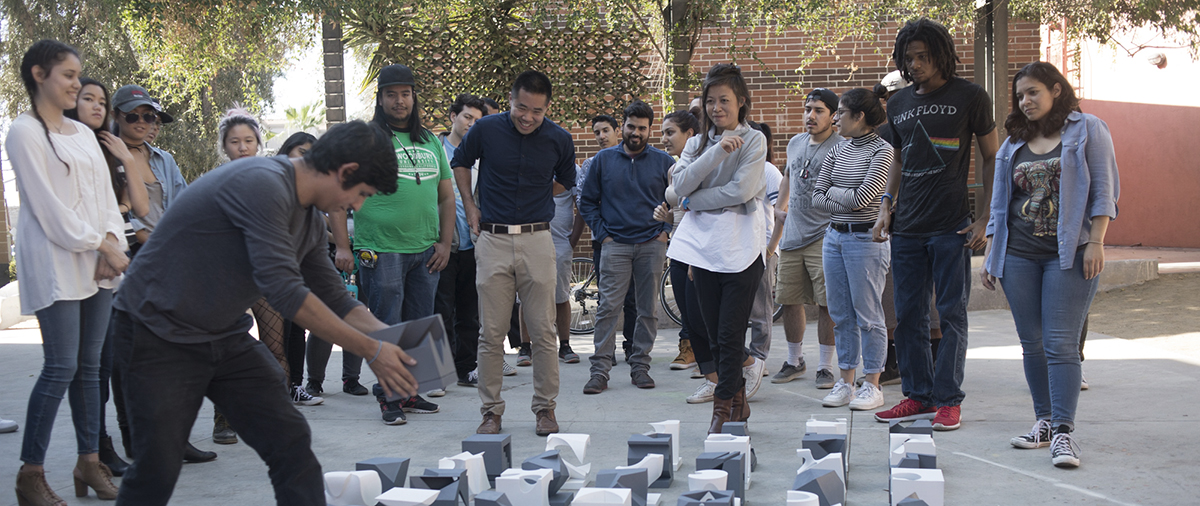Integrated Path to Architectural Licensure (IPAL) at Woodbury University
Final article in a three-part series for the California IPAL initiative schools.
Highlights of Woodbury University School of Architecture’s IPAL programs provided by Catherine Roussel, AIA.
Woodbury University Embraces Integrated Path to Licensure to Empower Change
Woodbury University School of Architecture has a long-standing engagement with practice. Recognizing that perspectives are shaped by experience, the School of Architecture is rethinking student learning to redefine professional engagement. Expanding the scope of architectural education, the university is strengthening its commitment to practice by preparing students to lead positive change in the built environment. As our first cohort of Integrated Path to Architectural Licensure (IPAL) students begin their second summer of work and newly accepted students are starting to work in offices, we see more clearly how the program can benefit firms and proactively support the profession. Looking forward, we encourage firms to partner with us in shaping new connections between education and practice.
When we first reached out to firms for their support of our IPAL proposal in 2014, we were met with universal support, recounts Dean Ingalill Wahlroos-Ritter, AIA. Fourteen firms wrote letters of support and pledged to work with students to fulfill their Architectural Experience Program (AXP) hours through the IPAL program. Though Woodbury University has long had a work experience requirement for undergraduate students in all disciplines, the IPAL program is more intense. In order to ensure student success, we established a competitive process where students must demonstrate commitment and readiness. In turn, partner firms recognize that they have a critical role in guiding interns through the AXP experience.

Image Courtesy of Woodbury School of Architecture
IPAL provides structure, through a partnership between firms and the academy, to help students complete both AXP and degree requirements, which together help prepare students for the Architect Registration Examination (ARE). While not everyone chooses this integrated path, it can be an invaluable process for those who do.
Bachelor of Architecture students have the opportunity to complete the five-year program in six years, incorporating two years of internship, and passing the ARE prior to receiving their BArch. Following their second year, participating students work each summer in an internship, and complete a one-year internship between their fourth and fifth years. Consequently, successful students have the opportunity to be licensed upon graduation (candidates must compete all licensure requirements, including [but not limited to] passage of all division of the ARE and passage of the CSE). Woodbury’s Master of Architecture program is among the first of four graduate programs accepted by the National Council of Architectural Registration Boards (NCARB) nationally. This path is set up to take students four years to complete with a summer internship between the first and second year and a one-year internship between their second and third years, finishing the AXP hours with one final summer of work.
This initiative would not be possible without our state board. Woodbury acknowledges the support of the California Architects Board and the decision to allow examination before graduation for IPAL students. These efforts are further supported by the Board’s decision to adopt NCARB’s recommended reduction in the hours required for AXP from 5,600 to 3,740 core hours for all candidates. Together, these changes have enabled IPAL programs to support students through all of the licensure requirements, encouraging students to engage with practice sooner and helping make licensure more attainable.
The IPAL option is generating interest among students to integrate their education with
experience. As one student observed, I really wanted to integrate work into my architectural education. I knew that combining the experience of both
would make me stronger and it has.
Catherine Herbst, architecture chair for Woodbury University’s San Diego campus, agrees that learning is
more effective when education and practice are integrated. It is a better way to learn.
Another student said she chose the
IPAL path in order to complete her studies and licensure as soon as possible because you
never know what will happen in the future.
“The sooner the students begin working in an office, the better. IPAL students, on the licensure track, are inspiring others and having a positive influence. However, one of the challenges has been giving work assignments to students so early in their professional degree program. We are having to rethink our internship program, and are making it stronger as a result.”
Late dean of Woodbury’s School of Architecture, Norman Millar who was a champion of the
IPAL initiative nationally, touched on the importance of
IPAL at Woodbury by saying that, From the perspective of a school with a
preponderance of first-generation college students who reflect the multicultural diversity of our region, we see
NCARB’s [Integrated] Path to Architectural Licensure initiative as an
important stepping stone to improving the diversity—including gender diversity—of licensed architects. We embrace the opportunity to work
closely with a consortium of architecture firms and our state board in the process.
The first cohort of IPAL students reflected that diversity and included seven women out of eight students at the Burbank campus. That has since leveled out to a more even ratio of men to women, with some international students joining the program. We now have 25 students and expect this number to grow each year until our first class graduates in 2020. Students interested in IPAL generally apply during their second year of the BArch program. We have also accepted some first-year students and will consider transfer students. In a summer internship, students can expect to fulfill 500–600 of their AXP hours.
We have not changed the curriculum; however, we are increasingly emphasizing skills in the first two years of the BArch program—to serve students through their academic studies as well as to prepare them for practice. Students also complete the first in a series of practice courses in their second year, in which they produce construction documents and learn Revit. Graduate students bring with them varied experience that also enriches their contribution to firms as they gain experience in practice.
With a growing consortium of firms in Los Angeles and San Diego who have hired qualified students, from global offices like NBBJ to Carrier Johnson in San Diego and Bestor Architecture in Los Angeles, Woodbury’s program is quickly gaining recognition. We invite any firms who are interested in preparing the next generation of architects for an increasingly complex world and expanding range of practice to contact us. Our team includes Dean Ingalill Wahlroos-Ritter, AIA, Architecture Chair, Catherine Herbst, AIA, (San Diego) as well as graduate and undergraduate Chairs, Ewan Branda and Heather Flood (Los Angeles), and Architect Licensing Advisor, Catherine M. Roussel, AIA. Information about the IPAL, BArch, and MArch programs are available on the Woodbury University website.
At Woodbury, we believe in the power of practice to empower change. By embracing IPAL, we’ve made concrete steps to building professional experiences that better serve both firms and students. We see the IPAL program as a vital opportunity to help students understand the built environment, expand their critical thinking skills, and engage with new design problems. We remain committed to professional development, partnering with firms and practices to give students well-rounded experiences and challenges that they are prepared to tackle. We appreciate the support of the California Architects Board, and we will continue to explore new education models like IPAL that allow students to address the complex demands inherent to contemporary practice.

